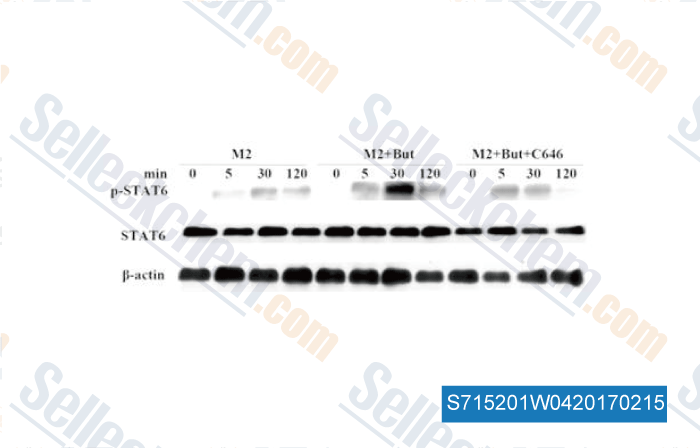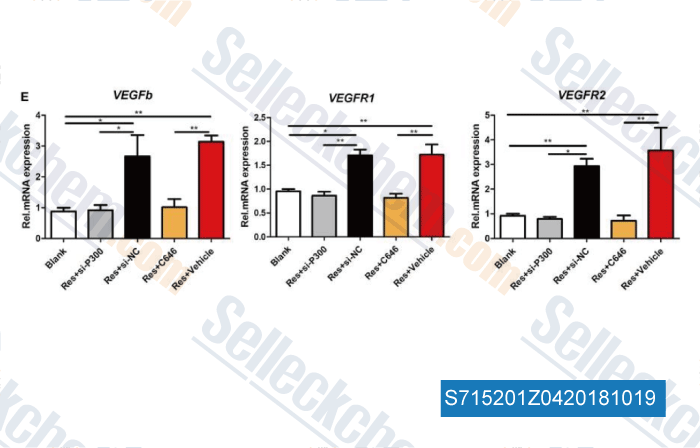|
Toll Free: (877) 796-6397 -- USA and Canada only -- |
Fax: +1-832-582-8590 Orders: +1-832-582-8158 |
Tech Support: +1-832-582-8158 Ext:3 Please provide your Order Number in the email. |
Technical Data
| Formula | C24H19N3O6 |
|||
| Molecular Weight | 445.42 | CAS No. | 328968-36-1 | |
| Solubility (25°C)* | In vitro | DMSO | 13 mg/mL (29.18 mM) | |
| Water | Insoluble | |||
| Ethanol | Insoluble | |||
|
* <1 mg/ml means slightly soluble or insoluble. * Please note that Selleck tests the solubility of all compounds in-house, and the actual solubility may differ slightly from published values. This is normal and is due to slight batch-to-batch variations. * Room temperature shipping (Stability testing shows this product can be shipped without any cooling measures.) |
||||
Preparing Stock Solutions
Biological Activity
| Description | C646 is an inhibitor for histone acetyltransferase, and inhibits p300 with a Ki of 400 nM in a cell-free assay. Preferentially selective for p300 versus other acetyltransferases. C646 induces cell cycle arrest, apoptosis and autophagy. | ||
|---|---|---|---|
| Targets |
|
||
| In vitro | C646 is an inhibitor for histone acetyltransferase, inhibits p300 with a Ki of 400 nM and is selective versus other acetyltransferases. C646 produces 86% inhibition of p300 in vitro at 10 μM. C646 is a classical reversible p300 inhibitor. C646 treatment (25μM) reduces histone H3 and H4 acetylation levels and abrogates TSA-induced acetylation in cells. [1] C646 (20μM) induces apoptosis in androgen-sensitive and castration-resistant prostate cancer cell lines by interfering with AR and NF-kB pathways. [2] C646 blocks dynamic acetylation of H3K4me3 globally in mouse and fly cells, and locally across the promoter and start-site of inducible genes in the mouse, thereby disrupting RNA polymerase II association and the activation of these genes. [3] | ||
| In vivo | C646 infused into the ILPFC immediately after weak extinction training enhances the consolidation of fear extinction memory. [4] C646 attenuates mechanical allodynia and thermal hyperalgesia, accompanied by a suppressed COX-2 expression, in the spinal cord. [5] | ||
| Features | Extensively used as a pharmacologic probe in cancer cells. Potential use for prostate and lung cancers. |
Protocol (from reference)
| Kinase Assay:[1] |
|
|---|---|
| Cell Assay:[1] |
|
| Animal Study:[4] |
|
References
Customer Product Validation

-
Data from [Data independently produced by , , Sci Rep, 2016, 6:24838.]

-
Data from [Data independently produced by , , Oncotarget, 2015, 6(31):31767-79.]

-
Data from [Data independently produced by , , Front Neurosci, 2018, doi:10.3389/fnins.2018.00341]

-
Data from [Data independently produced by , , Biol Reprod, 2015, 93(1): 13]
Selleck's C646 has been cited by 101 publications
| Musashi-2 potentiates colorectal cancer immune infiltration by regulating the post-translational modifications of HMGB1 to promote DCs maturation and migration [ Cell Commun Signal, 2024, 22(1):117] | PubMed: 38347600 |
| LINC00355 promotes gastric carcinogenesis by scaffolding p300 to activate CDC42 transcription and enhancing HNRNPA2B1 to stabilize CDC42 mRNA dependent on m6A [ Mol Carcinog, 2024, 63(3):430-447] | PubMed: 37983727 |
| NINJ1 regulates ferroptosis via xCT antiporter interaction and CoA modulation [ bioRxiv, 2024, 2024.02.22.581432] | PubMed: 38464226 |
| METTL14 Promotes Lipid Metabolism Reprogramming and Sustains Nasopharyngeal Carcinoma Progression via Enhancing m6A Modification of ANKRD22 mRNA [ Research Square, 2024, 10.21203/rs.3.rs-3834927/v1] | PubMed: none |
| Noncanonical CDK4 signaling rescues diabetes in a mouse model by promoting β cell differentiation [ J Clin Invest, 2023, 133(18)e166490] | PubMed: 37712417 |
| Hepatocyte HSPA12A inhibits macrophage chemotaxis and activation to attenuate liver ischemia/reperfusion injury via suppressing glycolysis-mediated HMGB1 lactylation and secretion of hepatocytes [ Theranostics, 2023, 13(11):3856-3871] | PubMed: 37441587 |
| Noncanonical CDK4 signaling rescues diabetes in a mouse model by promoting β cell differentiation [ J Clin Invest, 2023, 133(18)e166490] | PubMed: 37712417 |
| Priming therapy by targeting enhancer-initiated pathways in patient-derived pancreatic cancer cells [ EBioMedicine, 2023, 92:104602] | PubMed: 37148583 |
| Lactate promotes myogenesis via activating H3K9 lactylation-dependent up-regulation of Neu2 expression [ J Cachexia Sarcopenia Muscle, 2023, 10.1002/jcsm.13363] | PubMed: 37919243 |
| A regulatory circuit comprising the CBP and SIRT7 regulates FAM134B-mediated ER-phagy [ J Cell Biol, 2023, 222(5)e202201068] | PubMed: 37043189 |
RETURN POLICY
Selleck Chemical’s Unconditional Return Policy ensures a smooth online shopping experience for our customers. If you are in any way unsatisfied with your purchase, you may return any item(s) within 7 days of receiving it. In the event of product quality issues, either protocol related or product related problems, you may return any item(s) within 365 days from the original purchase date. Please follow the instructions below when returning products.
SHIPPING AND STORAGE
Selleck products are transported at room temperature. If you receive the product at room temperature, please rest assured, the Selleck Quality Inspection Department has conducted experiments to verify that the normal temperature placement of one month will not affect the biological activity of powder products. After collecting, please store the product according to the requirements described in the datasheet. Most Selleck products are stable under the recommended conditions.
NOT FOR HUMAN, VETERINARY DIAGNOSTIC OR THERAPEUTIC USE.
